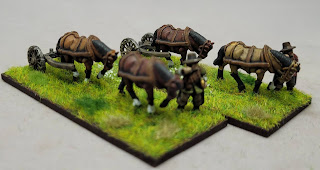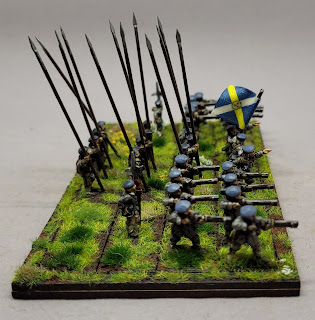Coat Colours Part 3: The Scots
The latest instalment of the coat colours series looks at the Scots. A set of coat colours that you can really go wild with the colour palette. Or maybe not.
When I wrote this I was only really interested in the Covenanters; for a slightly more in depth look at what well dressed Highlanders and Irishmen wore around town have a look Coat Colours Part 3b: The Army of Montrose.
The rest of my coat colour posts:
The too long didn't read answer is: paint it Hodden Grey.
Here's a list of regiments that have a reference for coats being issued - those coats issued, were 'probably Hodden Grey'.
Those regiments with a specific reference to Hodden Grey are described as 'Hodden Grey'. There are a handful of regiments who, wait for it, quite possibly didn't wear Hodden Grey.
Highland Regiments invariably wore highland dress - I've listed a couple of units that don't specifically have 'Highlanders' in their regimental title.
The phrase 'highland dress' will of course get a number of people very hot under the collar; suffice it to say that the modern 'kilt' looks nothing like traditional kilts, and the concept of tartan is a whole can of worms I have no desire to open. Google is your friend here, not me.
Which poses the question what colour is Hodden Grey?
Traditionally shown as a grey colour (as illustrated by the re-enactors above) Hodden Grey was in fact a name for the style of cloth - unbleached/undyed natural wool, rather than a specific colour.
Hodden Grey was made by mixing 'black' and white fleeces together in the proportion of one to twelve when weaving. But as black and darker sheep fleeces are brown the ensuing 'grey' mixes are most likely a range of browns and browny greys.
In the 1920s the skeleton of a man was found in the bogs of Quintfall Hill, he was dressed in Hodden Grey. His clothing was remarkably well preserved, and is well documented. Although dating from the 1690s the jacket and breeches are apparently the same as those worn during the Wars.
Quintfall Hill Man's clothes have been recreated a number of times, and images are widely available on the web.
According to the font of all knowledge (Wikipedia - don't laugh!) 'Hodden Grey' is a registered Trademark owned by The London Scottish Regimental Trust. A Google image search for this modern, consistent, fabric is probably a pretty good starting point to pick a central paint colour: then pick some lighter shades, some shades darker, and some greyer. This approach may help give a pleasing pastiche of seventeenth century Hodden Grey which would no doubt be a wide range of colours and shades.
For those of you wondering where most of this information comes from - A Regimental History of the Covenanting Armies 1639-1651, EM Furgol
The rest of my coat colour posts:
The too long didn't read answer is: paint it Hodden Grey.
Here's a list of regiments that have a reference for coats being issued - those coats issued, were 'probably Hodden Grey'.
Those regiments with a specific reference to Hodden Grey are described as 'Hodden Grey'. There are a handful of regiments who, wait for it, quite possibly didn't wear Hodden Grey.
Highland Regiments invariably wore highland dress - I've listed a couple of units that don't specifically have 'Highlanders' in their regimental title.
The phrase 'highland dress' will of course get a number of people very hot under the collar; suffice it to say that the modern 'kilt' looks nothing like traditional kilts, and the concept of tartan is a whole can of worms I have no desire to open. Google is your friend here, not me.
Which poses the question what colour is Hodden Grey?
Traditionally shown as a grey colour (as illustrated by the re-enactors above) Hodden Grey was in fact a name for the style of cloth - unbleached/undyed natural wool, rather than a specific colour.
 |
| Cheviots - an example of the colour of the white wool in the mix |
 |
| Hebridean sheep - an example of a black sheep, illustrating how 'not black' the 'black' in the mix was |
Hodden Grey was made by mixing 'black' and white fleeces together in the proportion of one to twelve when weaving. But as black and darker sheep fleeces are brown the ensuing 'grey' mixes are most likely a range of browns and browny greys.
In the 1920s the skeleton of a man was found in the bogs of Quintfall Hill, he was dressed in Hodden Grey. His clothing was remarkably well preserved, and is well documented. Although dating from the 1690s the jacket and breeches are apparently the same as those worn during the Wars.
Quintfall Hill Man's clothes have been recreated a number of times, and images are widely available on the web.
According to the font of all knowledge (Wikipedia - don't laugh!) 'Hodden Grey' is a registered Trademark owned by The London Scottish Regimental Trust. A Google image search for this modern, consistent, fabric is probably a pretty good starting point to pick a central paint colour: then pick some lighter shades, some shades darker, and some greyer. This approach may help give a pleasing pastiche of seventeenth century Hodden Grey which would no doubt be a wide range of colours and shades.
For those of you wondering where most of this information comes from - A Regimental History of the Covenanting Armies 1639-1651, EM Furgol
The Solemn League and Covenant
Probably
Hodden Grey
|
|
·
Marquis
of Argyll’s Highland
·
Earl of
Atholl
·
Lord
Balfour of Burleigh
·
Lord
Balmerino
·
Col
Harie Barclay
·
Lord
Bargany
·
Col
Gilbert Blair
·
Lord
Carnegie
·
Earl of
Crawford-Lindsay
·
Colonel
Richard Douglas
·
Sir
William Douglas of Kirkness
·
Sir
James Drummond of Machanie
·
Earl of
Dumfries
·
Earl of
Dunfermline
·
Lord
Elcho
·
Colonel
John Forbes of Leslie
·
Sir
Alexander Frazer of Philorth
·
Earl of
Glencairn (English service) later Col Robert Cunningham
|
·
Lord
Gordon
·
Sir
John Grey
·
Sir
John Haldane of Gleneagles
·
Duke of
Hamilton
·
Col
James Hay of Delgatty
·
Earl of
Home
·
Sir
John Innes
·
Col
George Keith of Aden
·
Earl of
Kellie
·
Sir
Andrew Kerr of Greenhead
·
Lord
Kilpont
·
Col John
Lindsay of Edzell
·
Earl
Marischal
·
Colonel
Harie Maule
·
Colonel
Patrick Maule
·
Sir
George Preston of Valleyfield
·
Earl of
Roxburgh
|
Hodden
Grey
|
|
·
Marquis
of Argyll’s Lowand
·
Earl of
Buccleugh later Col Walter Scott’s, then Col William Baillie’s
·
Earl of
Callendar
·
Sir
Mungo Campbell of Lawer (wore red breeches in 1639)
·
Earl of
Cassilis
·
Lord
Coupar
·
Master
of Cranstoun
·
Sir
James Douglas of Mouswall
·
Sir
William Douglas of Kilhead
·
Viscount
Dudhope
·
Sir
Alexander Gibson of Durie later Lord Sinclair’s
·
Sir Alexander
Hamilton
·
Sir
Patrick Hepburn of Waughton
·
Col
James Holborn
·
Sir
David Home of Wedderburn
·
Sir
John Home of Ayton later Col Ludovick Leslie’s
|
·
Viscount
Kenmure
·
Earl of
Lanark
·
Earl of
Lauderdale
·
Lord
Livingstone
·
Earl of
Lothian
·
Earl of
Loudon
·
Sergeant-Major-General
Colin Pitscottie
·
Col
James Rae
·
Sir
Thomas Ruthven of Freeland
·
Lord
Sinclair
·
Col
William Stewart
·
Earl of
Tullibardine
·
Sir
John Wauchope of Niddrie
·
Sir
James Wood of Balbegno
·
The
Master of Yester
|
Not-Hodden
Grey™
(the exciting bit) |
|
Sir George Buchannan
|
Blue 1639 (
|
Sir John Cochrane of that Ilk
later Robert Home of Heugh’s, then Col John Maxwell’s
|
Originally hodden grey, on return to Scotland in 1645 they wore red (A Regimental History of the Covenanting Armies 1639-1651, EM Furgol)
|
Earl of Eglinton later Col
James Montgomery
|
On return to Scotland in 1645
they wore red
|
Sir Arthur Erskine of
Scotscraig’s, the Ministers’ Regiment
|
Grey or black allegedly the regiment wore
black coats made from old clerical garb donated by the Ministers of Scotland. No original citation, nice story, good enough for me and a change from painting Hodden Grey!
|
The King’s Lifeguard (3rd
Civil War)
|
Presumed red - Lorne requested coats all of one colour, and Charles requisitioned coats for his army from Worcester clothiers just prior to the battle, neglecting to pay for them. Red would appear to be the most likely colour but is not definite. In June 2008 Prince Charles the Prince of Wales at last paid off the £453 and 3 shillings debt
|
Highland
Dress
|
|
·
Marquis
of Argyll’s Lifeguard
·
Allan
Cameron of Lochiel
|
It is presumed that the
Highland Regiments wore highland dress, the two regiments mentioned are only mentioned because they are not explicitly called Highland Regiments
|
The Army of Montrose | |
Probably Hodden Grey
| |
· Strathbogie Regiment
|
· Lord Kilpont
|
All other regiments are ‘unknown’
| |
The Irish Brigade
| |
‘Unknown’ believed to be civilian clothes
| |
Highland Dress
| |
It is presumed that the Highland Regiments wore highland dress If you enjoyed reading this, or any of the other posts, please consider supporting the blog. Thanks. | |











Interesting that "hodden grey" was originally a style/quality of cloth. I was told by Dave Ryan that this was once true of "scarlet" also and it only later became associated with bright red because that was the most common colour for that (particularly high) quality of cloth. Apparently, it was at least partially the origin of the myth that only the King's men were allowed to wear red. Looks like another "multi-coloured" force on the tabletop......
ReplyDeleteI didn't know that about 'scarlet'. Off to find out more about that one now...
DeleteNice Post
ReplyDeleteThanks
Delete